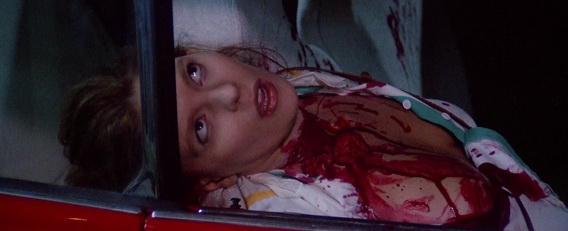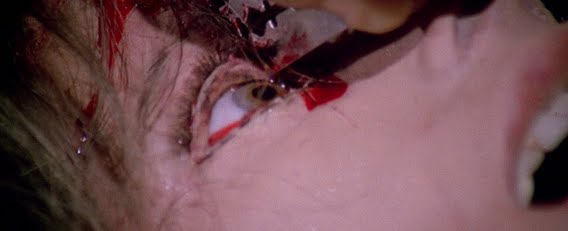
After a successful run of four zombie movies, Lucio Fulci decided to turn his attention to a new genre and eventually settled on the American slasher film. Whilst the likes of Halloween and Friday the 13th had invaded the mainstream, there were still certain filmmakers such as Bronx native William Lustig (who had, coincidentally, cut his teeth as an assistant on Dario Argento’s Inferno) who dared to challenge and provoke audiences with an onslaught of graphic and disturbing imagery. His commercial debut, the notorious Maniac, had focused on a loner with a penchant for scalping and murdering young women and had succeeded in disgusting its audiences and angering the critics. Eager to capitalise on this newfound controversy, Fulci felt it was time to return to the giallo genre which he had played a part in popularising and would mark his first since 1977’s Sette note in nero (aka The Psychic). Much like Maniac and fellow Italian filmmaker Romano Scavolini’s equally notorious Nightmare (more commonly known as Nightmare in a Damaged Brain), Fulci’s next project would be set on the sleazy streets of New York City as a serial killer terrorises and mutilates a selection of scantily clad women.
Despite Fulci’s earlier giallo efforts – 1971’s Una lucertola con la pelle di donna (A Lizard in a Woman’s Skin) and 1972’s Non si sevizia un paperino (Don’t Torture a Duckling) – featuring various grotesque images, he had decided that, much he had done with 1979’s Zombi 2 (which had been created to cash in on the success of George A. Romero’s Dawn of the Dead), he would draw influence from recent popular films and take them to the extreme. So whilst Maniac had flirted with voyeurism and misogyny, Fulci’s flick would revel in it. Whilst keeping with the police investigation formula that had become so popular throughout the seventies, Fulci would make use of the recent advancements of prosthetics to show in full view of the camera what he had only hinted at previously. Yet he was no stranger to controversy regarding the special effects in his movies, as back in 1971 makeup artist Carlo Rambaldi had been summoned to court in order to prove that the disembowelled dogs used in A Lizard in a Woman’s Skin were in fact artificial, as the director faced a prison sentence for cruelty to animals.
To develop his concept, Fulci would eventually approach three different writers to collaborate with on the screenplay. Gianfranco Clerici had already penned various spaghetti westerns by the time he wrote the 1971 thriller Una farfalla con le ali insanguinate (The Bloodstained Butterfly), but it would be his work with Ruggero Deodato on Ultimo mondo cannibale (Last Cannibal World), Cannibal Holocaust and La casa sperduta nel parco (The House on the Edge of the Park) which would bring him his greatest acclaim. Vincenzo Mannino had previously collaborated with Clerici on both 1974’s 5 donne per l’assassino (Five Women for the Killer) and the aforementioned rape/revenge drama The House on the Edge of the Park. Dardano Sacchetti had enjoyed immense success over the last decade alongside such respected directors as Dario Argento (Il gatto a nove code, aka The Cat O’ Nine Tails), Mario Bava (Reazione a catena, aka Twitch of the Death Nerve) and even Fulci (L’aldilà, aka The Beyond).
Their story would focus on a serial killer (who, bizarrely, adopts the voice of a duck as he taunts his victims, perhaps as a nod to Fulci’s own Don’t Torture a Duckling) who targets young women on the streets of New York, slicing and dicing them in all manner of grizzly ways. Among his methods of mutilation include disembowelment, cutting up a breast with a razor blade and Fulci’s personal favourite, the piercing of the eyeball (as previously utilised most famously in Zombi 2). Dispensing with a traditional narrative, the script served as a way for the director to move from one gruesome set piece to another, often with pornographic scenes woven in between. In one sequence, a woman becomes aroused whilst watching a sex show and begins to masturbate in the theatre. Another showed the same female being molested by a group of men in a bar with one of them sliding their toes into her underwear and stimulating her as his friend watches.
One aspect which would cause controversy amongst Fulci’s fanbase was his decision not to collaborate with his usual cohorts, most notably special effects artist Giannetto De Rossi (whom he had worked on occasional projects with since 1964’s I maniaci) and composer Fabio Frizzi (who had provided the memorable scores for Zombi 2 and Paura nella città dei morti viventi, aka City of the Living Dead). In their place he would hire Argento regular Germano Natali (Profono Rosso, aka Deep Red, Suspiria, Inferno) to provide the excessive bloodletting and Francesco De Masi to create the suitably sleazy music. Cinematographer Sergio Salvati would also be replaced by Luigi Kuveiller, whom the director had worked with earlier on A Lizard in a Woman’s Skin. He had also contributed to the unique look of Deep Red, as well as lensing Andy Warhol’s takes of both Frankenstein and Dracula.
As with much of his previous work, Fulci would cast an English speaking actor in the lead role, with London-born Jack Hedley portraying the central character Lt. Fred Williams. Hedley was a thirty year veteran of the industry and had made brief appearances in the likes of The Longest Day and Lawrence of Arabia before proving support on the Oscar nominated Goodbye Mr. Chips in 1969. Co-star Howard Ross had previously starred in Bava’s 5 bambole per la luna d’agosto (Five Dolls for an August Moon) whilst Andrea Occhipinti would appear the following year in Lamberto Bava’s La casa con la scala nel buio (A Blade in the Dark). Czech actress Zora Kerowa (real name Zora Keslerová), who was cast as one of the ‘performers’ during the sex show, had made a career out of making appearances in controversial Italian features, including Antropophagus and Cannibal ferox.
Filming commenced throughout April and May 1981 on location in New York, with addition scenes shot at Incir De Paolis Studios in Rome. The sequences at the university in which Dr. Paul Davis is on loan from were filmed at Columbia University on Broadway. Fulci himself would have a small role (as he often did in typical Hitchcock fashion) as the chief of police, declaring to the hero that “A smart-ass coroner comes out with a little verbal diarrhoea, and you immediately go around declaring there’s a maniac loose in the city.” The movie’s violent content would go so far as to include Kerowa’s character being stabbed in the vagina by a broken bottle. In fact, as has been noted previously by critics, women are not only penetrated by weapons (as is common with slashers, very rarely is a victim shot) but their most intimate areas are mutilated in extremely graphic detail.
Lo squartatore di New York was released in Italy on March 4 1982 and would become another success for Fulci, although now more than ever he was under fire for his treatment of women on screen. Under the name The New York Ripper, the movie would receive a far worse reception in Britain when, after having already rejected several of his other films (The Beyond, The House by the Cemetery and Zombi 2, under the name Zombie Flesh Eaters, had all been included on the Director of Public Prosecutions‘ ‘video nasty’ list), BBFC chairman James Ferman ordered all prints of The New York Ripper to be escorted out of the country. The film would eventually be granted a video release in the UK but even the recent DVD by Shameless was still cut by thirty four seconds, despite being available elsewhere uncensored. The New York Ripper, more than any other Fulci film, splits both critics and fans alike. Some praise his confrontational approach to the subject matter and use of excessive violence, whilst others condemn it as unnecessarily sleazy or simply pointless.


2 Responses to SPAGHETTI SLASHERS – The New York Ripper